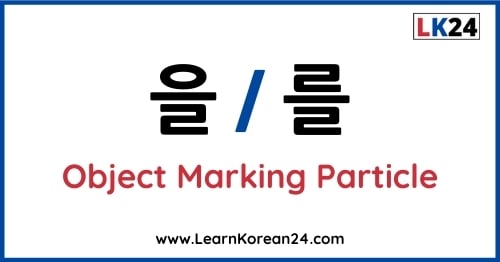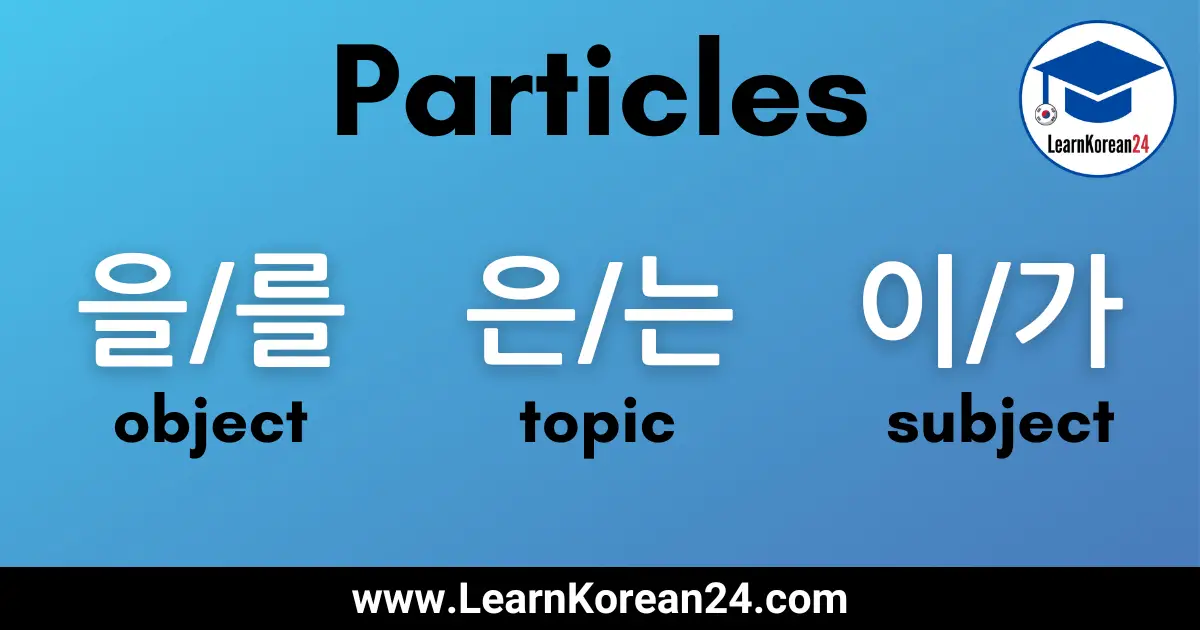Korean Particles Explained | Subject, Object, And Topic Markers
In this lesson, you will learn about the Korean particles 을/를, 은/는, and 이/가. English, like many other languages, does not have these ‘particles’ and so the concept of Korean particles may be a little difficult to understand at first. However, learning Korean particles is essential if you are going to understand Korean sentences and be understood when you make your own sentences. So, what are Korean particles?
Korean particles are suffixes that typically follow Korean nouns or pronouns to indicate a particular function or grammatical relation of that noun or pronoun.
Confused? Don’t worry. Below we will explain in detail what Korean particles are and provide plenty of examples to help you learn how to use Korean particles in Korean sentences. (FYI – This lesson includes both Korean characters and English romanization. If you would like to learn how to read Hangul, check out our free and complete guide to Reading The Korean Alphabet.)
Korean Particles
There are many particles in Korean, but in this lesson, we will focus on the essential Korean particles which are the object marking particle (을/를), the topic marking particle (은/는), and the subject marking particle (이/가).
Korean Object Marking Particles (을/를)

Korean object particles are used to indicate the object in a sentence. An object in a sentence is the noun that is being affected by a verb. For example, in the sentence ‘I like apples.’, the object of the sentence is ‘apple(s)’. ‘Apple(s)’ is the object because it is the thing that is being affected by the verb ‘like’ (i.e. the apples are being liked).
In English, there is nothing that ‘marks’ the object, but in Korean, 을 or 를 is used to mark the object in a sentence. For example, the sentence ‘I like apples.’ in Korean is 사과를 좋아해요 [sa-gwa-reul jo-a-hae-yo]. As you can see, 를 is attached to 사과 (apple) to mark it as the object of the sentence.
사과 = apple
사과를 = apple + object marking particle
좋아하다 = to like
좋아해요 = like (present tense)
사과를 좋아해요. = (I) like apples.
Choosing 을 or 를
When attaching the object marking particle, you must choose either 을 or 를. The one you choose depends on the noun that comes before it. 을 is attached to nouns that end in a consonant, and 를 is attached to nouns that end in a vowel. In the above example, 사과 ends in a vowel (ㅏ) so 를 was attached.
Examples
Here are some more Korean object marking particle examples:
- 책을 읽어요 [chaek-eul il-geo-yo] = read a book
- 바나나를 먹어요 [ba-na-na-reul meo-geo-yo] = eat a banana
- 차를 마셔요 [cha-reul ma-syeo-yo] = drink tea
- 케이크를 좋아해요. [ke-i-keu-reul jo-a-hae-yo] = (I) like cake.
Korean Topic Marking Particles – 은/는

A Korean topic marking particle lets the listener know that THAT NOUN is the topic of what you are talking about. For example, in the sentence, ‘Today is Monday.’, the topic is ‘today’. Again, in English, there is nothing that marks the topic in a sentence, but in Korean, the topic is marked with 은 or 는.
For example, in the sentence ‘Today is Monday.’, the topic, ‘today’, must be marked by the topic marking particle. So, ‘Today is Monday’ in Korean is 오늘은 월요일이에요 [o-neul-eun weol-yo-il-i-e-yo].
오늘 = [o-neul] = today
오늘은 [o-neul-eun] = today + topic marking particle 은
오늘은 월요일이에요 [o-neul-eun weol-yo-il-i-e-yo] = Today is Monday.
Choosing 은 or 는
When attaching a topic marking particle, you must choose either 은 or 는. The one you choose depends on the word that comes before it. 은 is used when the preceding word ends in a consonant, and 는 is used when the word ends in a vowel. In the above example, 은 is used because 오늘 ends in a consonant (ㄹ).
Examples
Here are some more Korean topics marking particle examples:
- 저는 사과를 좋아해요. = I like apples.
- 이 케이크는 맛있어요. = This cake is delicious.
- 저 사람은 누구예요? = Who is that person?
- 내일은 화요일이에요. = Tomorrow is Tuesday.
Korean Subject Marking Particles – 이/가

The Korean subject marking particle (이/가) is used to mark the subject in a sentence. If you’re not sure what a ‘subject’ is, a subject of a sentence is the person or thing that is doing an action (verbs) or being described (adjectives).
With Verbs
In the sentence ‘Sumin likes apples.’, ‘Sumin’ is the subject, ‘like’ is the verb, and apple(s) is the object. In this example, ‘Sumin’ is the subject because ‘Sumin’ is the person that is doing the verb (like). So, to say this sentence in Korean, we must mark ‘Sumin’ (수민) with the subject marking particle:
- 수민이 사과를 좋아해요. = Sumin likes apples.
With Adjectives
In the sentence, ‘The weather is cold.’, ‘the weather’ is the subject and ‘cold’ is the adjective. ‘The weather’ is the subject because it is the thing being described by the adjective (cold). So, to say this sentence in Korean, we must mark ‘the weather’ with the subject marking particle:
- 날씨가 추워요. = The weather is cold.
Choosing 이 or 가
이 is used when the preceding word ends in a consonant, and 가 is used when the word ends in a vowel. In the first example above, 이 was used because the name 수민 ends in a consonant (ㄴ). In the second example, 가 was used because 날씨 ends in a vowel (ㅣ)
Examples
Here are some more examples with the Korean subject marking particle 이/가:
- 은정씨가 김치를 좋아해요. = Eunjeong likes kimchi.
- 이 바나나가 맛있어요. = This banana is delicious.
- 그 가방이 싸요. = That bag is cheap.
- 물이 없어요. = There is no water.
Korean Particles Review Quiz
To review what you have learned in this lesson, check out this Korean particles quiz video below. This quiz has 10 questions and each question asks you to choose the correct Korean particle to complete the sentence. Enjoy! 🙂
Download Lesson PDF
Here is a FREE PDF of the key information from this lesson on Korean particles:
Don’t worry if you still find these Korean particles a little difficult to understand. Over time, as you learn more and more Korean, and you see these Korean particles in context, you will be able to understand them better. For now, just remember that 을/를 marks the object, 은/는 marks the topic, and 이/가 marks the subject. In the next lesson, we will teach you how to make Korean sentences using all the things you have learned in previous lessons.

